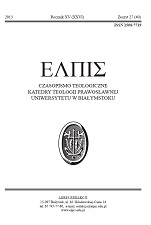Kim jest Jezus Chrystus dla ruskich i rosyjskich Świętych? Teologiczna analiza Żywotów Świętych św. Dymitra Rostowskiego
Author(s): Krzysztof Leśniewski / Language(s): Polish
/ Issue: 15/2013
Keywords: Jesus Christ; The Lives of the Saints; St Dimitry Rostovsky; Russian Orthodox Hagiography; The Paschal Mystery
Christian hagiography reveals not only the facts of life of individual saints, but first of all, it is a description of the experience of God loving mankind. From the beginning of Christianity, of great importance in building faith, hope andl ove had had stories about those believers who responded with a particular radicalism for the prevenient love of God in the Trinity of Persons. These stories have been written in various forms of literature.
Author in the introductory part of the article introduces into the lives of the saints and their role in the Ruthenian and Russian Orthodoxy. Essentially he focuses on presenting The Menaia edited by St Dimitry Rostovski. This book was published in the years 1711 to 1718 in Old Church Slavonic. At the beginning of the twentieth century, it has been rewritten and translated into Russian. This monumental work appeared in the years 1903-1911 under the title The Lives of the Saints. It has been a rich source of information for researchers from many disciplines.
From a theological point of view, the author studied The Lives of the Saints in order to find direct references to the person and teaching of Jesus Christ. For this purpose, he analyzed quotations from the New Testament, especially from the Gospel, referring directly to the Person and teaching of Jesus Christ, as well as the prayers addressed to Him. In his analysis, he searched for answers to the questions: Who is Jesus Christ for the Ruthenian and Russian saints, and what kind of His images predominate in The Lives of the Saints.
The first part of the article, on the basis of source texts, indicates personal qualities of Jesus Christ. The Savior has been experienced by the Ruthenian and Russian saints as God who is close to man, the blessed King, the best Lord, the Comforter of the crying, the Light, the merciful God, and the Foundation of all good. The image of Christ as sinless, innocent suffering and merciful shines especially in the devotion of Saints Passion-Bearers Boris and Gleb. In the consciousness of the Ruthenians Christ is not God who condemns the sinners, but God who wants to bring them to a change of heart and holiness. Christ is also the true Physician of souls and bodies.
In the second part of the article were shown images of Christ that occur while reading The Lives of the Saints. Some of these images relate to the Gospels, and others have as their bases an existential expression of faith in Jesus Christ. The Saints refer to Earthly life of Jesus by recalling images of Jesus in various situations (the image of Jesus tempted the desert; the image of the merciful Christ, who wants to lead a mind of man mired in spiritual disease to change and salvation; the image of Christ suffering voluntarily for the salvation of man). An important element of the image of Jesus Christ, typified in The Lives of the Saints is a reference to His suffering and death on the cross, which is supplemented by a triumphant image of the Risen Lord, who won
More...

